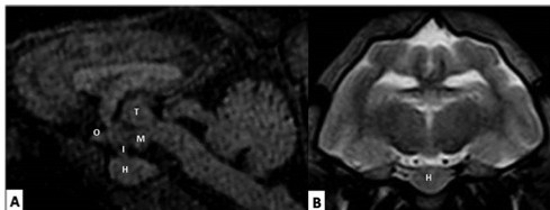Introduction
Capybara is the largest rodent with wide distribution in South America. The hypophysis is a reddish appendage attached at the ventral midline to the diencephalon and it plays a major regulatory role in the entire endocrine system.
Objectives
The aim of this partial study is to describe the hypophysis, or pituitary gland, in living capybara by means of MRI providing more detailed information of intracranial structures of this species, for research centers and clinics of wild animal veterinary medicine.
Methods
Eight adult capybaras were submitted to MRI examination using a 0.25 Tesla equipment (Vet-Grande; Esaote, Italy), under general anesthesia using face mask. The hypophysis was evaluated by T1W, T2W and FLAIR sequences on the transverse, sagittal and dorsal planes.
Results
Hypophysis is accommodated on the bony recess of the basisphenoid, or sella turcica, caudally to the optic chiasm and under the mamillary body (Figure 1). This gland is wide with oval form and isointense to the cerebral parenchyma.
| Figure 1 | 
(A) T1-weighted mid-sagittal and (B) T2-weighted transversal MRI showing the wide hypophysis (H) attached to ventral midline of brain. I = infundibulum; M = mamillary body; O = optic chiasm; T = interthalamic adhesions.
|
|
| |
Conclusions
While domestic animals have a short hypophysis, capybaras have a wide pituitary gland accommodated in a robust sella turcica.